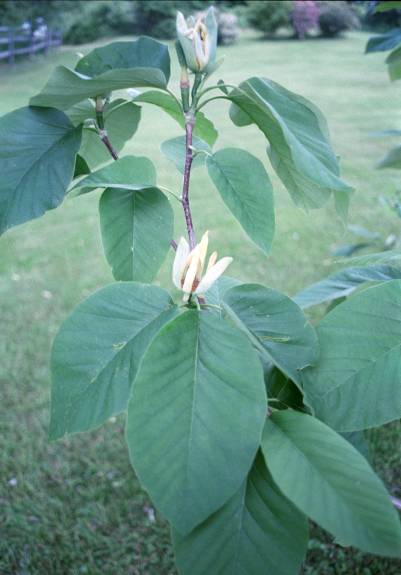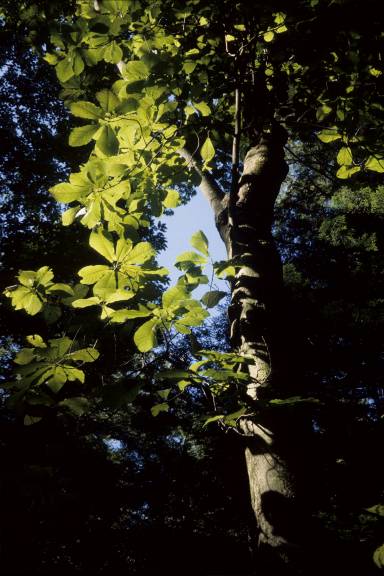|
==============================================================================
TOPIC: Bigleaf Magnolia.....anyone else love this
http://groups.google.com/group/entstrees/browse_thread/thread/2eb941671d1cae65?hl=en
==============================================================================
== 1 of 5 ==
Date: Fri, Feb 22 2008 8:31 am
From: Gary Smith
small to medium sized tree, Magnolia Macrophylla?
It is deciduous, and the fantastic leaves can reach up to 30 inches!
I believe it ranges from parts of the lower South on up into North
Carolina and Virginia in small pockets, so some of you might have
seen
them in the wild.
For the New England guys, I would think the Arnold Arboretum should
surely have some.
Beautiful tree, and becoming harder to find in the wild.
gs
== 2 of 5 ==
Date: Fri, Feb 22 2008 10:54 am
From: "Will Blozan"
Gary,
Check out Jess's and my report on Bankhead NF in Alabama.
Will
== 3 of 5 ==
Date: Fri, Feb 22 2008 11:15 am
From: ForestRuss@aol.com
Gary:
It is a fairly common understory tree on some of the better cove
sites in
central WV. The flower is incredibly large and very beautiful but it
stinks
horribly. I had no idea how foul the smell of the flowers was until
I picked a
blossom to take home to my wife...after about 200' of driving with
it in a
closed pickup I had to put the blossom in a plastic bag...when I
brought it
into the house it lasted about 30 seconds before it was displayed on
our front
porch. The blossoms are amazing from the standpoint of their large
size but
also because they last such a short while....barely 24 hours.
Russ
== 4 of 5 ==
Date: Fri, Feb 22 2008 6:43 pm
From: tsharp13@suddenlink.net
Russ: I believe the Magnolia we have here in central and southern
West
Virginia is M. tripetala or Umbrella Magnolia. Of course a lot of
people call in West Virginia use the term Big Leaf when referring to
this specis but The only Big Leaf (M. macrophyla) have even seen in
WV
has been planted. Turner Sharp
== 5 of 5 ==
Date: Fri, Feb 22 2008 8:52 pm
From: Beth Koebel
ENTS,
Lets not forget the northern most member of the
magnolia family, the tulip tree with its beautiful
greenish-yellow and orange "tulips".
Beth
"Information is moving--you know, nightly news is one way, of
course, but it's also moving through the blogosphere and through the
Internets."
Washington DC, May 2, 2007 George W. Bush
==============================================================================
TOPIC: Bigleaf Magnolia.....anyone else love this
http://groups.google.com/group/entstrees/browse_thread/thread/2eb941671d1cae65?hl=en
==============================================================================
== 1 of 13 ==
Date: Sat, Feb 23 2008 5:22 am
From: Larry
Gary, ENTS, Yes it is an Awesome tree. Prior to Hurricane Katrina
there was a place in the Black Creek Wilderness that had Hundreds of
them. One place in particular, sticks in my memory oh so well, for I
went there many times. I would pick flowers 10" Dia., and bring
them
home. In about a 10 acre area there must have been at least around
50
trees, most were mature in the Understory of the Big Pines. Sadly
this
place was severely damaged from Katrina. Im waiting for the tree
material to rot before my next visit. I did go in 07 and to give you
an idea of how bad it was, you could walk on trees for a quarter
mile
in places and never touch the ground! Can you imagine how many of
these trees were in the past! Larry
== 2 of 13 ==
Date: Sat, Feb 23 2008 5:23 am
From: ForestRuss@aol.com
Turner:
I just checked my copy of Brooks WV trees from 1920 and you are
correct the
tree I have seen is Magnolia tripetala.
The only difference is that in the 1920 book it is referred to as a
streamside species. In the central part of the state it can commonly
be found on
some of the very best growing sites.
Russ
== 3 of 13 ==
Date: Sat, Feb 23 2008 5:27 am
From: pabigtrees
ENTS
Magnolia tripetala, Umbrella magnolia, is becoming more common in
the
woods of Pennsylvania. Read invasive! Fairmount Park is covered with
it. I love the big leaf Magnolias. I have had trouble with M.
pyramidata. Doesn't seem to transplant easily. M. fraseri is cool
too. Has anyone run into M. ashei in the wild?
Scott
== 4 of 13 ==
Date: Sat, Feb 23 2008 6:25 am
From: "Will Blozan"
Beth,
And of course the northernmost true magnolia, M. acuminata-
cucumbertree. It
may also be the tallest and most voluminous magnolia.
Will
== 5 of 13 ==
Date: Sat, Feb 23 2008 7:10 am
From: Beth Koebel
Will,
I did not know that the cucumbertree was the northern
most true magnolia.
Beth
== 7 of 13 ==
Date: Sat, Feb 23 2008 8:46 am
From: "Edward Frank"
ENTS
Umbrella Magnolia is rare in Western PA. One occurrence is at
Ohiopyle State Park in extreme southern PA.
"Located primarily in Fayette County, Ohiopyle State Park
encompasses about 19,052 acres of rugged natural beauty and serves
as the gateway to the Laurel Mountains. The focal point of the area
is the more than 14 miles of the Youghiogheny River Gorge that
passes through the heart of the park."
It and several other species were transported here via the northward
flowing Youghiogheny River. It is a species Anthony Kelly and I
hoped to document in the park a year ago, but without leaves if we
saw it, we could not identify it, if we came across it at all.)
Ed
"Ferncliff Peninsula National Natural Landmark: Created by a
meander in the Youghiogheny River, this 100-acre peninsula is a
unique habitat that contains many rare and interesting plants. The
northern-flowing Youghiogeny River picks up seeds in Maryland and
West Virginia and deposits them at Ferncliff, north of their usual
growing range. The deep gorge is slightly warmer than the
surrounding area, which allows these southern refugees to survive.
Recognized for its botanical diversity for over a century, in 1973
the 100-acre peninsula was declared a National Natural Landmark. In
1992, Ferncliff Peninsula was declared a State Park Natural Area
which will protect it in a natural state."
== 8 of 13 ==
Date: Sat, Feb 23 2008 10:26 am
From: abies2@u.washington.edu
Greetings,
Records in China indicate that M. campbellii is every bit as tall
and voluminous as M. acuminata. Here on the west coast the two show
similar horsepower.
Cheers,
- BVP
== 9 of 13 ==
Date: Sat, Feb 23 2008 11:08 am
From: doug bidlack
ENTS,
there is also a famous population of sweetbay magnolia
(Magnolia virginiana) on Cape Ann in Gloucester,
Massachusetts. This appears to be as far, or nearly
as far north as the western New York populations of
cucumbertree magnolias.
Doug
== 11 of 13 ==
Date: Sat, Feb 23 2008 6:07 pm
From: JamesRobertSmith
A few times, hiking in the Southern Apps, I came across these
absolutely enormous leaves. Just stunningly huge. These must have
been
from cucumber trees. On several hikes. Can't recall the locations,
but
I seem to have seen them in Panthertown Valley, which is certainly
not
known for old trees.
== 12 of 13 ==
Date: Sat, Feb 23 2008 6:39 pm
From: "Will Blozan"
James,
You are probably seeing leaves of Magnolia fraseri; Fraser magnolia.
Their
leaves are much larger than cucumbertree. Look for the distinctive
"earlobes" at the base of the leaf. Cucumber leaves do not
have the lobes;
hence the epithet of acuminata (?).
Here is a cucumber tree.

And here is a Fraser magnolia.

Will
== 13 of 13 ==
Date: Sat, Feb 23 2008 6:42 pm
From: Gary Smith
Scott, I'm thinking m. ashei can be found naturally growing in just
a
small area of the SE. I'm thinking the northern FL, southern GA
area,
but could be a little off.
I have seen it in one retail nursery in LA.
gs
==============================================================================
TOPIC: Bigleaf Magnolia.....anyone else love this
http://groups.google.com/group/entstrees/browse_thread/thread/2eb941671d1cae65?hl=en
==============================================================================
== 1 of 2 ==
Date: Sun, Feb 24 2008 11:01 am
From: neil
ENTS:
There is a neat entry in Donald Culross Peattie's "A Natural
History of
Trees of Eastern and Central North America'. One of my favorite
parts of
the entry discusses the famous botanists Andre Michaux's passion for
bigleaf Magnolia after seeing it in full bloom near Charlotte, NC.
Peattie writes:
"Having once discovered so notable an addition to this
continent's
famous list of native Magnolias, Michaux was forever watching for
it.
And thus he found again this queenliest of all deciduous Magnolias
while
he was passing through "the wilderness" of the Cumberland
Mountains,
through which Daniel Boone, only nineteen years before, has cut the
Wilderness Trail."
Peattie also discusses how Michaux looked for it in the Knoxville
area,
beginning on June 4, 1795 and found it four days later in a
"bottom-lands" [incidentally, on the 15th of that month he
found himself
at the house of Mr. Jackson - Old Hickory].
I've been amazed at the amount of bigleaf Magnolia in the Red River
Gorge area of eastern Kentucky. Hiking out to an arch in the gorge
last
summer, I came across a valley choked with bigleaf Magnolia
saplings.
I've never seen an area so full of the deciduous Magnolias as the
Red
River Gorge.
neil
== 2 of 2 ==
Date: Sun, Feb 24 2008 11:04 am
From: neil
Will et al.,
As ENTS has discovered, M. acuminata is also the oldest Magnolia to
date. The specimen from Cook Forest, PA had a max age in the 430s. A
couple individuals at Fiddlers Green in the central Blue Ridge
Mountains
of VA were 310-330+ yrs. Southern Magnolia may come close to that
age
someday There just isn't too much data to support such a great age
for
that species.
neil
|